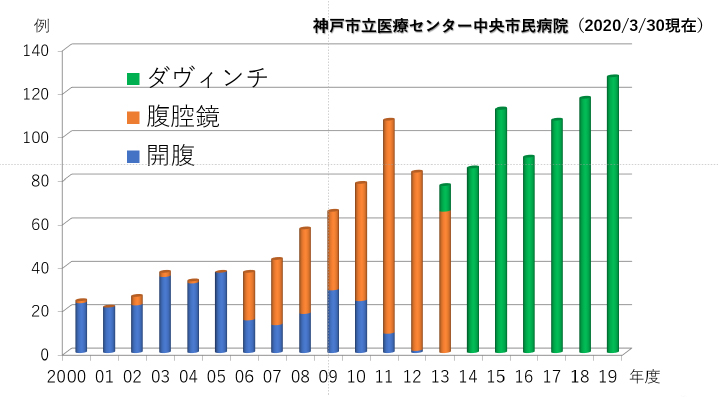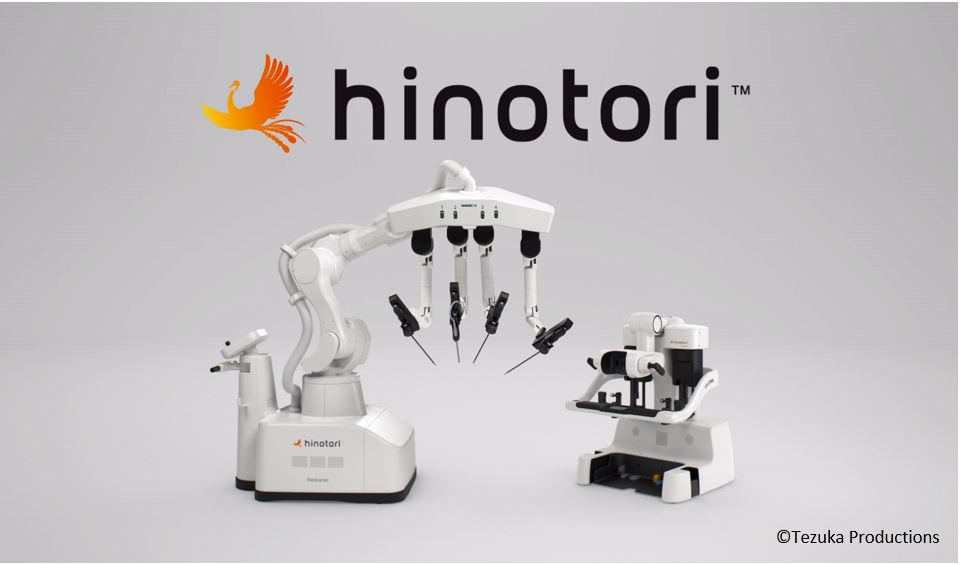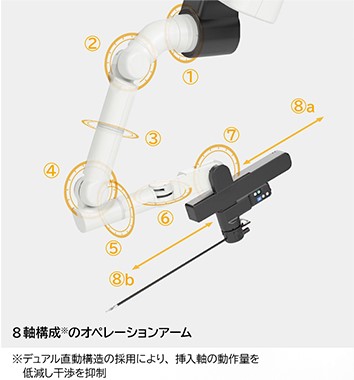Robotic Surgery Center
Robotic surgery, which has become one of the routine medical treatments worldwide, started to be covered by health insurance in Japan in 2014 for prostate cancer in the Urology field. Robotic surgery here refers to surgery performed by attaching a robot to a conventional laparoscope or thoracoscope. In addition to the advantages of a small wound and less bleeding due to the pressure of the pneumoperitoneum caused by carbon dioxide gas in the laparoscopic procedure, it is possible to magnify and view stereoscopically, and fine manipulation is possible with freely moving forceps. By remote control, the operator can freely move the camera and three arms by himself. In January 2014, our hospital started robot-assisted surgery using the da Vinci Si. In August 2019, the Da Vinci Xi was newly introduced, creating a two-unit system. .
Partial nephrectomy for kidney cancer in 2016, heart valve surgery, mediastinal tumor, lung cancer, esophageal cancer, stomach cancer, rectal cancer, bladder cancer in 2018 Cancer, endometrial cancer, benign uterine tumors such as uterine fibroids, thymectomy, pancreatic cancer, pyeloplasty, pelvic organ prolapse in 2020, Cardiovascular Surgery, Respiratory Sugery Robotic surgery has been approved for surgical procedures in many clinical departments such as gastroenterological surgery and gynecology. In May 2017, our hospital established a Robotic Surgery Center to expand robotic surgery in anticipation of future expansion, including Otorhinolaryngology, thoracic surgery, gastrointestinal surgery, Urology, and Obstetrics and Gynecology and gynecology. , Nursing Department, ME, office work, etc. We are strengthening the cooperation and coordination system of related departments.
In order to introduce a new technique, it is necessary to train robot-Certified Physician, invite proctors several times to introduce the surgery, and secure the number of cases to obtain a certified facility. In order to obtain a Certified Physician, each doctor is required to practice using a simulator, train on animals, and observe surgery at a designated educational facility. In addition, some expenses will be borne by the hospital before the facility is certified.
And the most important thing is to safely introduce a new surgical procedure. In order to ensure that patients undergoing surgery are not in any serious danger, relevant departments will work closely together, repeat simulations before introduction, identify and resolve questions and inadequacies before and after surgery, and ensure smooth operation. It is the mission of this center to help facilitate the introduction.
Surgical support robot Da Vinci
Overview of the Robotic Surgery Center
Table 1 shows the clinical departments, target surgeries, and an overview of surgeries at our center.
table 1
| Configuration clinical department | Target surgery | remarks |
| Urology |
|
Prostate cancer since 2014, renal cancer since 2016, bladder cancer since 2018, and pyeloplasty since 2020 have been performed as regular insurance treatments. Since 2020, we have started paying only the surgical fee for pelvic organ prolapse (up to 4 cases) at the hospital. Prostate cancer 649 cases Kidney cancer 220 cases 40 cases of bladder cancer (As of March 2020) |
|---|---|---|
| surgery |
|
Stomach cancer: We carry out as insurance medical treatment from June, 2018. Esophageal cancer, rectal cancer: We carry out as insurance medical treatment from October, 2018. |
| Obstetrics and Gynecology |
|
Early-stage endometrial cancer: Since October 2018, it has been covered by health insurance. |
| Otorhinolaryngology |
|
We will respond accordingly. |
| Respiratory Sugery |
|
We will respond accordingly. |
| Cardiovascular Surgery |
|
The conditions for applying for surgery have been met and the application is being prepared. Expected to start this year |
Robot-assisted (da Vinci) surgery in our hospital
Urology
So far, we have performed more than 400 cases of laparoscopic radical prostatectomy in our Urology. Taking advantage of this experience, the introduction of the first case of da Vinci surgery in January 2014 went smoothly without any problems. In April 2020, we will reach 650 cases of robot-assisted radical prostatectomy, and we would like to continue aiming to improve cancer control and functional preservation (Fig. 1). In addition, partial resection of kidney cancer was started in February 2015, before insurance coverage, and 220 cases were performed by March 2020. In addition to the three-dimensional field of view, the ease of incision and suturing with scissors that allow delicate movements shortens the time required for renal artery ischemia compared to laparoscopy, and significantly improves postoperative preservation of renal function. increase. Total cystectomy, which was started before insurance coverage started, has also been performed in 40 cases. From April 2020, we also started pyeloplasty and sacral vaginoplasty.
surgery
At our hospital, gastric cancer has been covered by health insurance since June 2018, and esophageal and rectal cancer since October 2018. Da Vinci surgery itself can be performed at the same surgery cost as normal laparoscopic surgery or thoracoscopic surgery, and the high-cost medical expense system applies to the patient's cost (out-of-pocket maximum amount). . Please see below for details.
To all users of the Ministry of Health, Labor and ministry of Health, Labor and Welfare notation high-cost medical care benefit systemCurrently, almost all cases of esophageal cancer are performed by da Vinci surgery, and the proportion of gastric cancer and rectal cancer among laparoscopic surgery that da Vinci surgery accounts for is increasing year by year. For gastric cancer, we perform not only pyloric side gastrectomy and total gastrectomy, but also cardic side gastrectomy in order to preserve function (to preserve as much of the stomach as possible). For rectal cancer, we perform surgery with an awareness of postoperative QOL (quality of life) to avoid deterioration of urinary and defecation function by preserving nerves while maintaining curability.
If you have any questions related to da Vinci surgery for each organ or disease, please feel free to contact the outpatient surgery department. We have a specialist for each organ, so we will respond appropriately.
Gynecology
Laparoscopic surgery for gynecological malignant tumors (uterine cancer, ovarian cancer, etc.) became covered by insurance in 2014 for early-stage endometrial cancer. I have undergone radical surgery for endometrial cancer. Compared to open surgery, laparoscopic surgery is less invasive (= less burden on the body) for the patient, and features less postoperative pain and faster recovery. Robot-assisted (da Vinci) surgery is positioned as an extension of laparoscopic surgery and is similarly minimally invasive. Because it can be performed, more precise and careful surgery becomes possible in the narrow pelvis.
Robot-assisted (da Vinci) surgery for early-stage endometrial cancer became insurance coverage in April 2018. At our hospital, we introduced this surgery in April 2018, and by March 2020, we have performed this surgery on about 40 patients, contributing to a better postoperative life for the patients. In addition, the new Xi, X, which was introduced in 2019, is less invasive than ever before and is suitable for many patients, making it easier for us to handle.
Cardiovascular Surgery
In our department, we have been performing mitral valvuloplasty with right minithoracotomy for mitral regurgitation. Recently, all procedures are performed under a complete endoscope, making it possible to approach skin incision in the same way as robotic surgery. We have met all the application requirements for the robot and are preparing to apply and start this year. We believe that we will be able to provide high-quality robotic surgery to more patients by making use of our experience.
Characteristics of robot-assisted (da Vinci) surgery (Tables 1, 2)
The da Vinci has the advantage of its three-dimensional expanded field of view and operability, and the pneumoperitoneum pressure produced by the laparoscope results in less bleeding and quicker recovery. On the other hand, there are drawbacks such as the high cost of the device itself and forceps, lack of tactile sensation, and difficulty in responding to emergencies.
Table 2: Advantages and disadvantages of da Vinci surgery compared to conventional surgery
| merit | Demerit | |
| for the patient |
|
|
|---|---|---|
| For surgeons and hospitals Take |
|
|
Table 3: Comparison of open surgery, robot-assisted surgery, and laparoscopic surgery
| conventional surgery | Da Vinci | laparoscope | |
| created | big | small | small |
|---|---|---|---|
| position | moderate | sometimes excessive | sometimes excessive |
| enthusiasm | none | can be | can be |
| field of view | 1 to 4 times | 10-40 times | 2-10 times |
| three-dimensional effect | can be | Emphasis | with 3D camera |
| Flexibility of equipment | same as human hand | more freedom than humans | Limited by trocar* |
| suture operation | Difficult in deep and narrow places | easy everywhere | extremely difficult |
| amount of bleeding | often | Few | Few |
| surgery time | short | short | somewhat long |
| emergency | easy to deal with | hard to deal with | Somewhat difficult to deal with |
| Postoperative recovery | slow | quick | quick |
| Length of hospital stay | long | short | short |
| hospitalization costs | somewhat cheap | high | somewhat expensive |
| equipment cost | somewhat low | very high | somewhat expensive |
*Trocar: In laparoscopy and thoracoscopy, a cylindrical object is placed in the body wall, and various instruments are inserted from here to perform surgery.
Robot-assisted (da Vinci) surgery in Japan
In Japan, the use of the da Vinci S was approved in 2010, and in 2012 it was covered by insurance for prostate cancer (Fig. 8). The da Vinci Si was introduced in the same year, and in 2014 partial nephrectomy for kidney cancer was covered by insurance. More than 13,000 surgeries were performed in 2015, mostly in Urology. As of June 2016, 228 da Vinci have been introduced in Japan, making it the second largest country in the world with 2,300 da Vinci after the United States. In 2018, heart valve surgery, mediastinal tumor, lung cancer, esophageal cancer, stomach cancer, rectal cancer, bladder cancer, endometrial cancer, benign uterine tumors such as uterine fibroids, thymectomy in 2020, It is applied to pancreatic cancer, pyeloplasty, and pelvic organ prolapse surgery, and may rapidly spread to many clinical departments such as Cardiovascular Surgery, Respiratory Sugery, gastrointestinal surgery, and gynecology in the future.
Robot-assisted (da Vinci) surgery
The da Vinci is made by Intuitive Surgical in the United States and consists of three parts: a surgery console on which the surgeon sits and operates the surgery, and a patient cart that actually moves the camera and three arms at the bedside of the surgery. There is a vision cart that sends images to the surgery console and surrounding monitors and recording devices, and transmits commands from the surgeon to the patient cart (Fig. 1).
The operator sits on the operation console and operates the camera and three arms with his/her hands and feet while looking at an enlarged 3D high-definition screen (Fig. 2). The endo-wrist, which has one more degree of freedom than a human wrist (Fig. 3), enables incisions and sutures in all directions, allowing surgery to be performed as if one's own hands were inside the patient's body (Fig. 4). ). With the motion scaling function, for example, even if the controller is moved 3 cm, the forceps can be set to move only 1 cm. It also has a device that absorbs camera shake, maximizing the ability of the operator.
Robotic Assisted (da Vinci) Surgery Development and Global Status


With the exception of South Korea and China, where there are robots that can only be used domestically, no surgical robot other than Da Vinci has yet appeared. We expect to see several new models in the 2020s.

Prospects for future robot-assisted surgery
Since the number of robot-assisted surgeries covered by health insurance is increasing every two years, it is expected that almost all surgeries that are performed using endoscopes will be performed by robots in the near future. If the development of new robots progresses both in Japan and overseas, we can expect cost reductions due to price competition, and we believe that robot-assisted surgery will become more popular all over the world.
Furthermore, due to technological innovation, compact robots, robots with independent arms, robots with tactile sensations and navigation systems, etc. have appeared, and with the introduction of AI, robots that are not operated by human hands will also be developed. In this way, it is expected that robotic medicine will continue to evolve.
2020.4.16 (Responsible for the text) Robotic Surgery Center Chokane Urology Director
Mutsuji Kawakita
Surgical support robot hinotori
Introduction of surgical assistance robot hinotori
In August 2020, da Vinci was almost monopolized in robot-assisted surgery worldwide, but in August 2020, the surgery-assisting robot system "hinotori TM" (Fig. From September 1, 2019, the Urology has been covered by insurance. Furthermore, in October 2022, insurance coverage will be approved for gastroenterological surgery and gynecology, and it is scheduled to be covered by insurance by the end of 2022. The name of this system, "hinotori," was adopted from the masterpiece "Phoenix," which was written throughout the life of Osamu Tezuka, one of Japan's leading cartoonists and doctor, who confronted the preciousness of life.
Medicaroid, a manufacturer with a history of more than 50 years, is a joint venture between Kawasaki Heavy Industries, Ltd., a leading company in industrial robots, and Sysmex Corporation, which possesses testing and diagnostic technologies and has a wide network in the medical field. Established in Kobe in 2013 through joint investment. hinotor was developed as a surgical assistance robot that realizes the fine movements required for surgery, and is based on the concept of a robot that "serves and supports people" rather than "replaces people".
The surgical assistance robot hinotori consists of three units: an operation unit, a surgery cockpit, and a vision unit (Fig. 2). The arm of the operation unit that performs the surgery consists of eight axes, which is more than the da Vinci, and moves smoothly like a human arm. This contributes to smoother surgery (Fig. 3). One of the major features of hinotori is that the arm and trocar do not need to be docked, so the area around the trocar is neat and the assistant can easily move and assist (Fig. 4). By storing the insertion position of the trocar and moving around it, it is possible to set it so that the movement of the arm does not damage the abdominal wall. The monitor of the surgery cockpit is ergonomically designed so that it can be manually and instantaneously adjusted to the surgeon's preferred posture (Fig. 5). It reduces the burden on the surgeon and supports stress-free surgery. The vision unit displays high-definition endoscopic images in 3D on the surgery cockpit and supports smooth communication between the surgeon and the assistant doctor.
In August 2022, our hospital introduced the surgical assistance robot hinotori, and plans to start using it in November of the same year. This will be the third machine in addition to the existing da Vinci Xi and X, and will respond to the rapid increase in the number of cases. We will start with radical prostatectomy in Urology and gradually expand to other surgical procedures.
2022.10.25 (Responsibility) Robotic Surgery Center Chokane Urology Director
Mutsuji Kawakita












